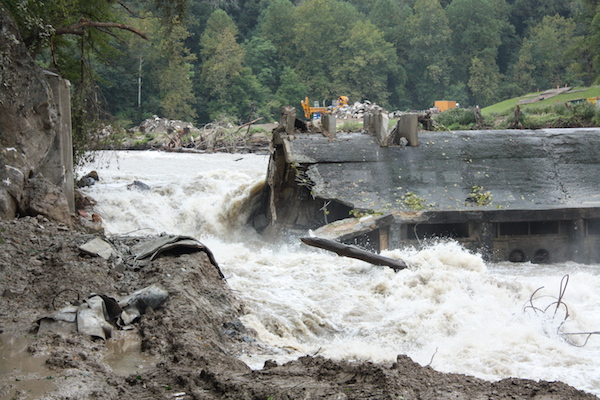SEJournal Online is the digital news magazine of the Society of Environmental Journalists. Learn more about SEJournal Online, including submission, subscription and advertising information.
 |
| Breaching of the Bloede Dam on the Patapsco River outside of Baltimore in September 2018. The state of Maryland will remove the dam, built more than a century ago as a source of hydropower for Baltimore's suburbs, in order to restore about 65 miles of habitat for fish, wildlife and recreation. Photo: Jessie Thomas-Blate, Flickr Creative Commons. Click to enlarge. |
TipSheet: Dam Removal May Provide Environmental News Near You
With worries about dam failures in the wake of Hurricane Florence (see recent headlines here, here and here), now might be a good time to watch your area for dam-removal projects. It’s a story that affects the lives of people in their communities — not to mention the lives of fish and wildlife.
Some 86 dams of all types and sizes were removed in the United States in 2017, according to the advocacy group American Rivers. And the number is growing.
Dams have a lot of benefits: hydropower, water supply, irrigation, flood control, navigation, recreation and more. Dam-building over the past century or more has helped develop much of the country.
But dams also cause harm. They obstruct passage of fish that migrate upstream to spawn. The reservoirs they create displace people and destroy habitat. They can sometimes make flooding worse, and, if they fail catastrophically, they may endanger lives and property. Plus, they cost money to build.
One other thing: Dams do not live forever. This is a fact often overlooked by the political visionaries with golden shovels who dedicate them in expectation of votes, applause and eternal glory.
The reservoir behind a dam will fill up over the years with most of the sediment that the river is transporting downstream That means the reservoir holds less and less actual water, which destroys its usefulness.
Moreover, aging dams, often built with obsolete engineering and construction methods, eventually start to crumble, making them hazardous. Neglecting maintenance makes it worse.
The safety issues don’t all involve dam failure. Even low dams (or weirs) on recreational rivers may often claim the lives of swimmers and boaters caught in churning circular currents just downstream.
That is the reason, for example, that planners urged removal of some dams on the Fox River in Illinois.
Dams removed in Washington state, Maryland
The U.S. landscape is still dotted with old dams once used for hydropower, which for various reasons have long since stopped generating electricity.
So while far fewer dams are being built today than 50 years ago, far more dams are being removed.
Possibly the most famous (and largest) dam-removal project in recent years was the Elwha Dam on the Elwha River in Washington (plus its upstream sister, the Glines Canyon Dam). It was inside the Olympic National Park until it was removed in 2011-12.
Built a century earlier for hydropower, the dam meant “game over” for the hundreds of thousands of salmon (and other species) that spawned throughout dozens of miles of upstream habitat.
Today, years after demolition, the accumulated upstream sediment is building a new delta at the Elwha’s mouth.
While far fewer dams are
being built today than 50 years ago,
far more dams are being removed.
Another example is the Bloede Dam on the Patapsco River outside of Baltimore. Recently the state of Maryland began the process of blowing it up and removing it, chunk by chunk.
Removal will restore about 65 miles of habitat for shad, herring and wildlife. Moreover, it will improve recreation opportunities (e.g., kayaking) in the popular Patapsco Valley State Park.
Built 110 years ago for hydropower to help grow Baltimore’s suburbs, the dam’s removal demonstrates how technologies and land use change. Soon, its removal will enhance (via recreation) the value of living in the surrounding suburbs.
One complication. The Patapsco is tributary to the Chesapeake Bay, a regionally important estuary struggling with its own nutrient and sediment problems. What happens when dam removal flushes sediment into the Bay is a matter of interest. Researchers plan to use drones to track it.
Tracking local dam removals, local issues
Dams, and dam removal, are a portal to a world of environmental issues that need coverage.
For example, natural fish populations support the many species that prey on them (e.g., bald eagles and kingfishers). Natural banks support riparian species (e.g., muskrats) and adapted vegetation.
But what’s important are the special issues that arise in your own area or region.
Finding dam-removal projects (or hopes of them) isn’t hard. The universe of larger dams in the United States is catalogued in the National Inventory of Dams, or NID, online and searchable (if incomplete) here.
American Rivers has the best database of dam-removal projects, available in both map and database form. American Rivers also has some helpful experts you can talk to; start here.
Some things to remember:
The vast majority of the dams in the United States are owned and operated by private parties, not government agencies, and these often are on private land.
It is also worth remembering that the biggest portion of dams are small — so small they are not included in the NID. Many of these are essentially unused and obsolete, and would be ripe for removal if somebody would pay for it and give permission.
Some other information sources to know about include the National Hydropower Association and the American Society of Civil Engineers.
Plus, there’s an SEJournal Toolbox on dams data, which includes more sources, a Toolbox on finding stories with the NID and a TipSheet on stories around dam safety.
* From the weekly news magazine SEJournal Online, Vol. 3, No. 35. Content from each new issue of SEJournal Online is available to the public via the SEJournal Online main page. Subscribe to the e-newsletter here. And see past issues of the SEJournal archived here.














 Advertisement
Advertisement 



